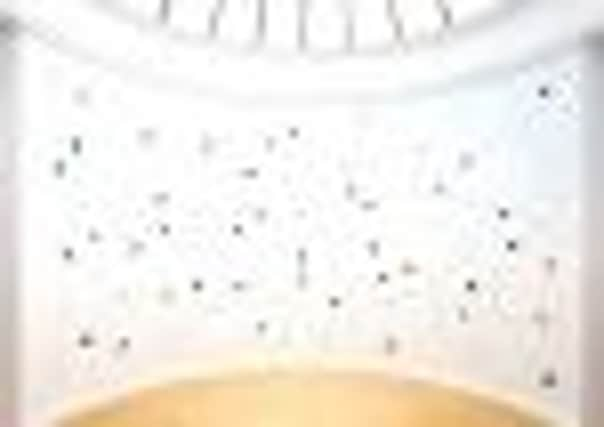Art review: Alison Turnbull, Talbot Rice Gallery, Edinburgh


Modern scholars have established that his description, the beryl in the beryl blue, came from a remarkable source: a small, but hugely ambitious, book from Edinburgh. Werner’s Nomenclature Of Colours, which was written by the Edinburgh flower painter Patrick Syme and published in 1814, sailed with Darwin on the Beagle and provided the fledgling naturalist with a colour vocabulary to describe his findings.
You can see an original edition of the book at Edinburgh University’s Talbot Rice Gallery this month as part of an exhibition by London-based painter Alison Turnbull.
Advertisement
Hide AdAdvertisement
Hide AdIt sits in a pleasingly old-fashioned cabinet amongst some specimens from the original collection of minerals that Syme used. When he created his book version of the academic colour charts established by Werner, a German mineralogist, the Edinburgh painter was combining his skills as an artist with the latest tools in scientific knowledge. It was hardly the white heat of technology, however – the book was hand-coloured and came with a warning not to leave it lying out in the sun.
The university once held the minerals on show; the Talbot Rice Gallery is on the sites of the university’s natural history museum and a lecture theatre, where Darwin studied. The stones now belong to the National Museum of Scotland, but in preparing a new site-specific painting for her exhibition, Turnbull has rather privileged access to her source material. “The museum has been very generous in loaning me the mineral specimens to work from in my studio in London,” she explains in the catalogue. “It was quite something to get a polished ruby in the post!”
Syme’s book was an attempt to catalogue colours as they were found in animal, vegetable and mineral material. For Turnbull’s exhibition it is open at pages for yellow. Straw Yellow, Syme writes, can be found in the polar bear, in oat straw and in the mineral schorlite. Sienna Yellow is seen in the vent parts of the tail of a bird of paradise, the stamen of honeysuckle and the pale Brazilian topaz.
Syme’s efforts were serviceable although, modern experts maintain, incomplete. Turnbull’s project has not been to test his hypotheses but to play with them. She has transformed the Talbot Rice’s round room gallery, the circular space beneath the building’s glass cupola, by creating a huge wall painting of coloured spots, each linked to the rest like a giant molecular diagram. Many of the colours have been directly transcribed from their mineral sources. It’s a lovely painting: not quite one thing or another. It has its roots in hard science, but it’s not an attempt to emulate it.
Syme’s work has long been important to Turnbull, who trained in Madrid before settling in London. It was a happy coincidence that a book she had long been intrigued by should be so intimately associated with the gallery.
Amongst the other works in her show is an affectionate emulation of Syme’s work, Orto Bianco, a black and white photograph of an old walled garden accompanied by a colour chart and text. Each colour corresponds to a description of its source, but whether these are real or imaginary, indeed whether the artist ever even visited the garden to make these observations, is left to the viewer to decide. Amongst the greens for example are “dirty old green hose” and “pale green sawdust spilling out of the felled tree.” And in the reds: “luminous red flashing light of the tractor”.
These two works seem typical of Turnbull’s inclination to turn systems into something more intimate and poetic and to turn methods of classification, representation or description into something more expansive. Each sits on a kind of fence between the optical, the stuff she presents in paint or pencil right in front of you, and the imaginative, something that exists way beyond the picture itself.
Advertisement
Hide AdAdvertisement
Hide AdThere are lots of examples of this in a show that seems quiet and self-contained but in fact alludes to vast ideas of science, architecture or the natural world. A muted painting of wheel-like forms actually derives from the architectural plans for a lighthouse: each floor shown separately as though the building had been salami sliced. When you try to imagine the lighthouse itself you are taken beyond the two dimensions of the painting into thinking about a complex three-dimensional form and then further still into imagining the sea that might surround it.
In the same way, Turnbull has worked with star maps, and sky atlases, as well as drawing directly on an ordnance survey map of the Minch. Some of these large-scale works are astonishingly beautiful; some seem a little too rigid. A sequence of lovely monochrome paintings (in singing red and blue) are overlaid with tight grids and enamel dots to create veils and skeins of marks like a shimmering galaxy.
Turnbull’s most modest works seem a far cry from that splendidly showy wall drawing, but they also speak of maps and charts and of world travels. Wherever she goes, and it turns out she is remarkably well travelled, the artist collects pre-printed paper: lined paper, graph paper, even it seems examination scripts. Each is modified by her own hand to create elaborate, geometric patterns: circles wheel across the page, chequered patterns emerge, and stripes become plaid. Three tables of these small drawings are incremental little treasures. Minute observations, as Darwin was to discover with glaciers, can add up to much bigger ideas. «
• Until 5 May